Intelligentized control technology of the semi- dry type manufactured sand production technology
A technology of production process and control technology, applied in the direction of manufacturing tools, metal processing equipment, casting and molding equipment, etc., can solve the problems of high automatic control voice and high labor control cost, eliminate pollution, reduce material reliability test costs, guarantee The effect of stability
- Summary
- Abstract
- Description
- Claims
- Application Information
AI Technical Summary
Problems solved by technology
Method used
Image
Examples
Embodiment 1
[0023] Embodiment 1: Install the production line according to the technical requirements of the semi-dry artificial sand sand making process shown in Figure 1 and Figure 2.
[0024]The semi-dry sand making process system is mainly composed of coarse crushing 1, semi-finished product bin 2, pre-screening workshop spray system 3, medium crushing workshop 4, first screening workshop spray system 8, 1# transfer bin 17, a The first-level fine crushing workshop is composed of water adding system, second screening workshop 14, second-level fine crushing workshop 15, belt conveyor and sand water recovery system; the automatic control technology is mainly composed of automatic control of artificial sand fineness modulus, automatic control of stone powder content and finished product The automatic control of sand moisture content consists of three parts. The system equipment consists of a belt machine load detection device 20, a sand moisture detection device 19, an electric adjustable f...
PUM
| Property | Measurement | Unit |
|---|---|---|
| Particle size | aaaaa | aaaaa |
Abstract
Description
Claims
Application Information
 Login to View More
Login to View More - R&D
- Intellectual Property
- Life Sciences
- Materials
- Tech Scout
- Unparalleled Data Quality
- Higher Quality Content
- 60% Fewer Hallucinations
Browse by: Latest US Patents, China's latest patents, Technical Efficacy Thesaurus, Application Domain, Technology Topic, Popular Technical Reports.
© 2025 PatSnap. All rights reserved.Legal|Privacy policy|Modern Slavery Act Transparency Statement|Sitemap|About US| Contact US: help@patsnap.com


